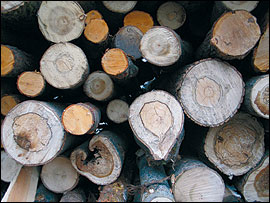 |
Power plants burning plantsTake wood chips, sawdust and agricultural waste. Add some wood products from Slovakia, black coal, and logs from Ukraine. Throw it into the local burner and voila! Electricity. |
 |
Under the proposed pilot project, local farmers would cut invasive species like False Indigo for AES to burn for energy. Farmers then replant areas with hemp and other plants, cultivate them and supply AES with more biomass. |
Most residents in Tiszaujvaros, in northeast Hungary, worked in local coal-burning plants, factories and farms until communism ended. After that, incomes and security for factory workers and farmers fell drastically.
In 1996, three local plants were purchased by AES, a US-based power company with operations in over 26 countries. Since then, employment increased. From 2003–05, the power generation sources for two plants went from brown coal to ‘biomass energy’ from vegetation.
Based on 2004 figures, AES generated 37% of Hungary’s total renewable energy.
Biomass energy produces less greenhouse gas emissions
than does coal, oil or gas. “When you burn a plant, the amount of carbon absorbed and released are the same making a zero effect on carbon emissions,” says Jean-Philippe Denruyter, Climate Change & Energy Policy Officer with WWF’s European Policy Office in Brussels.
Hungary’s target for using renewable energy as part of total energy production is 3.6% by 2010. “It’s a very low target, the lowest in the EU,” says Laszlo Balla, Corporate Support Leader for AES-Tisza Power Plant Ltd. AES would prefer 6% to improve national energy security and boost biomass production.
WWF is even more ambitious with a 20% target for Hungary. It also wants AES to throw other local plants into the burner like hemp – a traditional, native species
growing dense and tall in upper floodplain areas. “We’re working with AES to define sustainable biomass farming,” says Charlie Avis, who manages WWF’s ‘One Europe, More Nature’ project.
AES has been developing a programme for renewable energy generation that includes identifying the best lands and plants around Tiszaujvaros for biomass burning. “We want to find new fuel sources,” says Balla. “The next step is to mobilise local farmers to change their activities to growing the biomass.”
Local farmers own some 15,000 hectares of land around Tiszaujvaros. Some lands are affected by floods, surface groundwater and droughts. “Once subsidies to farmers end, such sensitive lands will be the first to be withdrawn from agricultural production,” says WWF-Hungary’s Csaba Vaszko. “It makes sense to convert them to biomass production.”
Another goal is in reach. Lush wetlands around Tiszaujvaros
were drained for producing corn and other crops decades ago. “We can now bring them back through an overall wetland restoration and protection plan,” says Vaszko. “We’d like the government, AES and farmers to get involved.”
A pilot project is expected for launch soon. If all goes right, AES would have a long-term sustainable supply for biomass energy. Local farmers would get work, transportation costs would be reduced and wetlands would be restored.
In low-lying areas, plans are being developed for AES and the Hungarian government to assist in wetland restoration. The wetland area is already one of the government’s future ‘water reservoirs’ geared to help flood protection
efforts by temporarily storing peak water volumes. “We’d like the government to make more than just bathtubs,” says Avis. “We’d like a mix of uses that’s good for everyone and wetlands.”
For more information, please visit: www.panda.org/europe/oemn